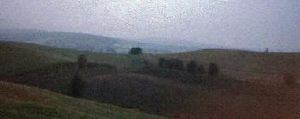Misk Hills facts for kids
The Misk Hills are a group of gently rolling hills made of sandstone. You can find them in Nottinghamshire, England, between the towns of Hucknall and Annesley. From these hills, you can see great views looking south towards Hucknall and the City of Nottingham. Many people think of the Misk Hills as the very start of the larger Pennine hill range. They reach a height of 170 metres (about 558 feet) above sea level, rising from the flat lands to the east. Three small streams, the Gilt Brook, the Whyburn, and Farleys Brook, all start in these hills. The Misk Hills also act as a natural border, separating the Leen Valley from the Erewash Valley.
Contents
What Makes the Misk Hills Special?
The Misk Hills are not just pretty; they also have some interesting connections to famous writers and history.
Literary Links: Poets and Authors
The Misk Hills have inspired several well-known writers.
Lord Byron's Poetic Views
One of the most famous connections is to Lord Byron, a very important English poet from the Romantic era. He lived nearby at Newstead Abbey. The view from Diadem Hill, which is the easternmost part of the Misk Hills, was the setting for his poem The Dream.
Byron also wrote another poem called 'The Hills of Annesley' about this area:
-
- Hills of Annesley, bleak and barren,
- Where my thoughtless childhood strayed,
- How the northern tempests, warring,
- How about thy tufted shade!
- Now no more, the hours beguiling
- Former favourite haunts I see,
- Now no more, my Mary smiling,
- Makes ye seem a heaven to me.
Other Authors Inspired by the Hills
The Misk Hills were also mentioned by D. H. Lawrence, a local author, in his book Sons and Lovers. Another writer from Nottingham, Alan Sillitoe, even wrote a poem specifically titled View from Misk Hill.
Where Did the Name "Misk" Come From?
No one is completely sure where the name "Misk" comes from. Some people think it might come from an Old English word for the moon, misor. Others believe it could be from an Anglo-Saxon word, miersc, which means 'boundary'. The Misk Hills are located near an old boundary between two ancient tribes: the Pecsaetan Anglian tribe and the kingdom of Mercia. Interestingly, there's also a place called Misk in Scotland, which is a range of sand hills.
How Are the Misk Hills Used Today?
The Misk Hills are used for many different things.
Farming and Forests
Farmers use the land for both dairy farming (raising cows for milk) and growing crops. There are also areas of commercial forestry, where trees are grown for wood.
Outdoor Activities
The hills are a very popular spot for outdoor activities. People love to go walking, horse riding, and cycling here.
Wildlife in the Hills
If you visit, you might spot some local wildlife! Skylarks, fallow deer, and hares all live in the area.
Transport and Tourism
The M1 motorway crosses through the area near junction 27. The Misk Hills are also a key part of the 'Hidden Valleys' area, which is promoted by the local councils (Ashfield and Gedling). This initiative aims to encourage tourism in what used to be a coal mining region of Nottinghamshire.
Historical Structures
At the bottom of Diadem Hill, you can find the remains of Annesley Castle. This was a motte and bailey fortification, which is a type of castle built on a mound of earth. You can often see it from the A611 Annesley Bypass as it goes through the hills.
Past Uses and History
The Misk Hills have a few interesting historical facts.
Victorian Era Dump
Long ago, during the Victorian era, there was a refuse dump (a place where rubbish was thrown) in the area. Even today, you can sometimes find pieces of old blue and white pottery scattered across the hills.
World War Two Shelter
During World War Two, a bomb shelter was built on top of the hills. Nearby Hucknall was a target for bombers because it had an RAF (Royal Air Force) base, a Rolls Royce engineering factory, and many coal mines.
Microlight Landing Strip
At one point, there was even a landing strip for microlight aircraft (small, lightweight planes) in the hills.


